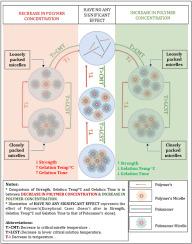Poloxamer's/Pluronic's® 凝胶化中的混合诱导变化:热力学和流变学视角
Q3 Materials Science
引用次数: 0
摘要
两亲嵌段共聚物(ABC)目前在制药科学领域具有重要意义,因为它们具有开发各种高效药物输送结构的特殊能力。Poloxamers,有时也被称为 Pluronic®,因其卓越的生物相容性和适应性而备受瞩目。Poloxamers是一种非离子三嵌段共聚物,由亲水性聚环氧乙烷(PEO)和疏水性聚环氧丙烷(PPO)组成,其排列顺序为PEO-PPO-PEO。由于这种排列方式,它们能够将药物包裹在疏水性核心中,并在超过一定临界胶束浓度(CMC)和温度(CMT)的水溶液中自组装成胶束。要了解和优化这些系统,就必须彻底理解胶束化过程及其热力学,其中包括自由能、焓和熵的变化。由于分子量和 PEO 与 PPO 的比例不同,会形成几种不同的多聚酰胺,每种多聚酰胺都具有独特的性质和用途。本文探讨了胶束化过程、胶束结构、热力学因素以及临界胶束浓度 (CMC) 和临界胶束温度 (CMT) 的重要性。它强调了这些参数在药物制剂和给药系统中的重要性。本文章由计算机程序翻译,如有差异,请以英文原文为准。

Blending induced variations in Poloxamer's/Pluronic's® gelation: Thermodynamic and rheological perspectives
Amphiphilic block copolymers (ABCs) are currently significant in pharmaceutical sciences because of their specific capability to develop various structures that are highly efficient for drug delivery. Poloxamers, sometimes referred to as Pluronic's®, are very remarkable due to their exceptional biocompatibility and adaptability. Poloxamers are a type of nonionic triblock copolymers that consist of hydrophilic poly(ethylene oxide) (PEO) and hydrophobic poly(propylene oxide) (PPO) organized in a sequence of PEO-PPO-PEO. Due to this arrangement, they are able to encapsulate drugs within their hydrophobic core and self-assemble into micelles in aqueous solutions beyond certain critical micelle concentrations (CMC) and temperatures (CMTs). Understanding and optimising these systems requires a thorough comprehension of the micellisation process and its thermodynamics, which encompass the changes in free energy, enthalpy, and entropy. Differences in molecular weight and the proportion of PEO to PPO lead to the formation of several different poloxamers, each possessing unique properties and uses. This paper examines the process of micellisation, the structure of micelles, thermodynamic factors, and the importance of critical micelle concentration (CMC) and critical micelle temperature (CMT). It emphasizes the significance of these parameters in pharmaceutical formulations and drug delivery systems.
求助全文
通过发布文献求助,成功后即可免费获取论文全文。
去求助
来源期刊

JCIS open
Physical and Theoretical Chemistry, Colloid and Surface Chemistry, Surfaces, Coatings and Films
CiteScore
4.10
自引率
0.00%
发文量
0
审稿时长
36 days
 求助内容:
求助内容: 应助结果提醒方式:
应助结果提醒方式:


